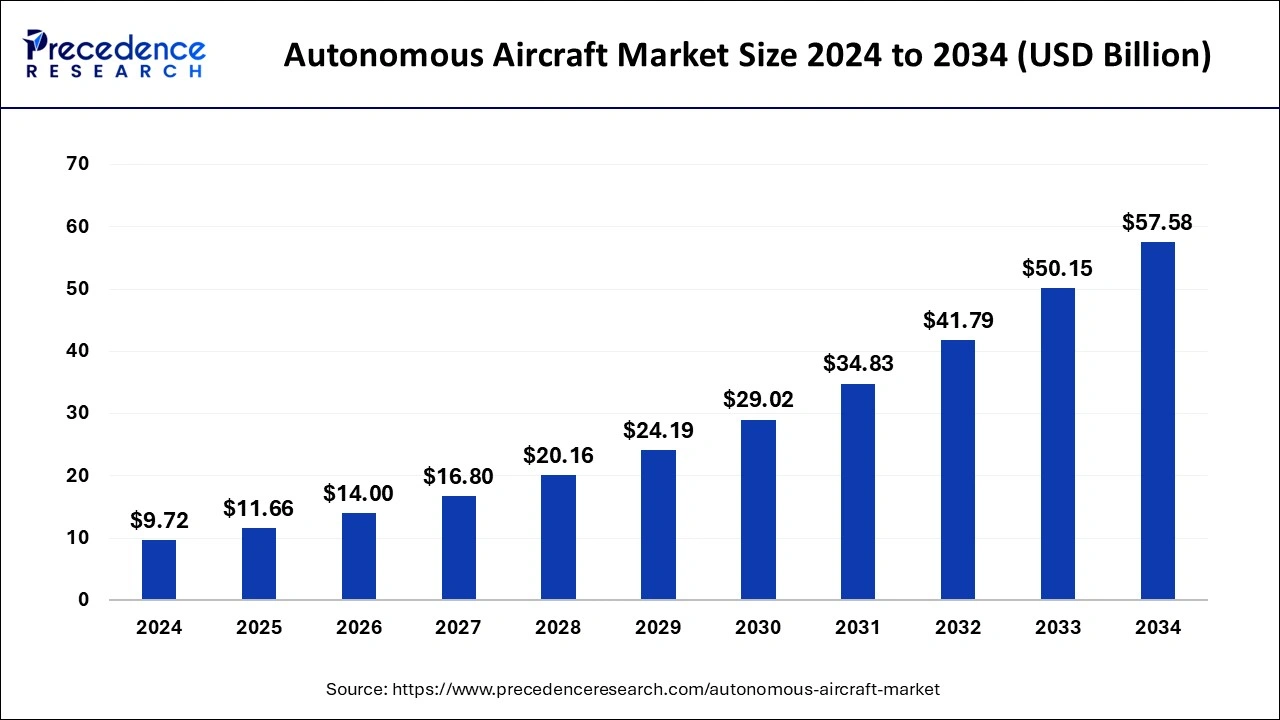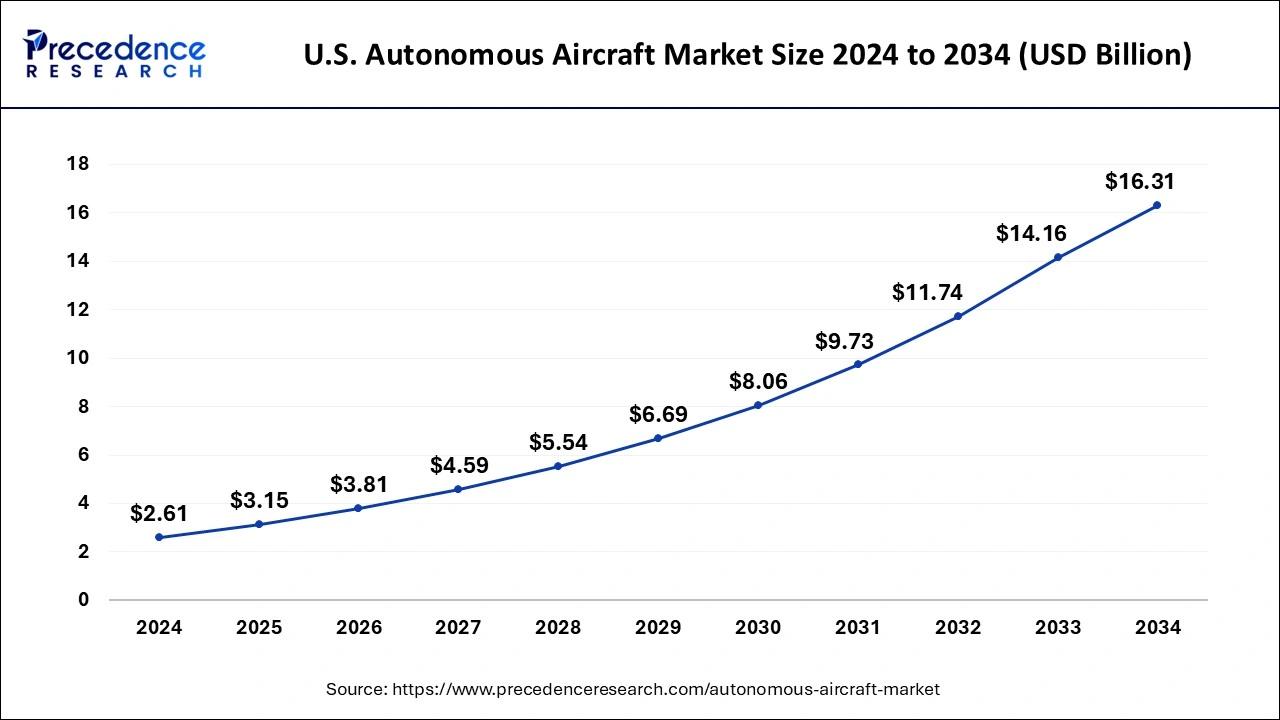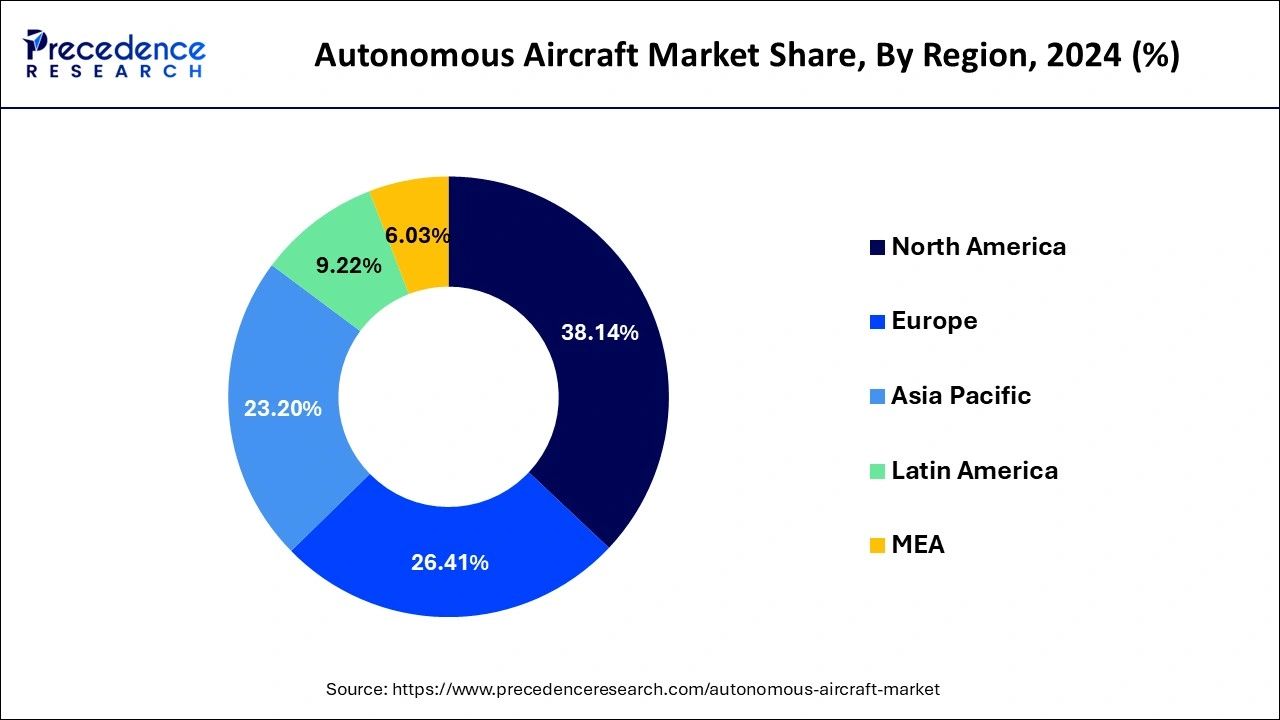March 2025
The global autonomous aircraft market size is calculated at USD 11.66 billion in 2025 and is forecasted to reach around USD 57.58 billion by 2034, accelerating at a CAGR of 19.47% from 2025 to 2034. The North America autonomous aircraft market size surpassed USD 3.71 billion in 2024 and is expanding at a CAGR of 19.50% during the forecast period. The market sizing and forecasts are revenue-based (USD Million/Billion), with 2024 as the base year.
The global autonomous aircraft market size was valued at USD 9.72 billion in 2024 and it is estimated to reach around USD 57.58 billion by 2034 with a registered CAGR of 19.47% from 2025 to 2034. The growth of the autonomous aircraft market is due to advanced AI technology, low charges, and less human error.

As per the International Civil Aviation Organization (ICAO) autonomous aircraft can be defined as an unmanned or fully-automated aircrafts that has no pilot interventions during a flight. Presently, the aircrafts used by military and civil organizations require help of pilots and to some extent they have autopilot features as well. Similarly, in autonomous aircrafts a pilot can switch to full operation mode whenever required and rest of the time can take the benefit of autonomous features provided in the plane. Autonomous technologies reduce the risk of accidents and mishappening during the flight; hence, witness exponential growth in the market revenue during the forthcoming years.
The incorporation of AI in the autonomous aircraft market increases the safety, capabilities, and efficiency of the market. It can analyse the details in real-time weather patterns and help to adjust aircraft accordingly. Artificial intelligence can track and analyse any malfunctioning and maintenance required which avoids any critical condition before time. It can introduce technologies such as machine learning and generative designs which support enhanced aerodynamics and decrease the weight, and structure of the aircraft. The adoption of AI and IoT offers high precision, speed, accuracy, and real-time information to the operators which are boosting the adoption of autonomous aircraft.
The U.S. autonomous aircraft market size was estimated at USD 2.61 billion in 2024 and is predicted to be worth around USD 16.31 billion by 2034, at a CAGR of 20.11% from 2025 to 2034.

North America accounted for the largest market share in the global autonomous aircraft market in 2024. North America is home to the leading aircraft vendors like Boeing Company, AeroVironment, Lockheed Martin Corporation, and Northrop Grumman Corporation. The surging investments by these leading players in the research and development activities and adoption of AI and IoT technologies in their aircrafts has significantly augmented the growth of the North America autonomous aircraft market. The increased demand for the autonomous aircrafts in the US military for rescue, search, and surveillance operations has led to the higher demand for the autonomous aircrafts in North America. This region is expected to sustain its position in the global autonomous aircraft market throughout the forecast period.

Asia Pacific is expected to be the fastest-growing market during the forecast period. The surging military budgets of the government in the nations like China and India are significantly driving the growth of the Asia Pacific autonomous aircraft market. The border disputes of China and India with their neighboring countries and growing need for supplying various necessity goods to the various military bases at the mountainous regions is expected to boost the demand for the autonomous aircrafts. Further, the demand is growing significantly for rescue operations and surveillance activities.
Autonomous aircraft are being used to deliver drugs during medical emergencies. There are several environmental incidents like natural disasters and calamities in various nations and autonomous aircraft serve as the only medium of transporting food and other necessary products. Moreover, the rising number of air accidents due to human errors is fueling the demand for autonomous aircraft to reduce accidents by eliminating human errors. The rising investments in research and development to discover the potential applications of AI and IoT in the aircraft industry are expected to boost the growth of the global autonomous aircraft market during the forecast period.
| Report Coverage | Details |
| Market Size in 2025 | USD 11.66 Billion |
| Market Size by 2034 | USD 57.58 Billion |
| Growth Rate from 2025 to 2034 | CAGR of 19.47% |
| Largest Market | North America |
| Fastest Growing Region | Asia Pacific |
| Base Year | 2024 |
| Forecast Period | 2025 to 2034 |
| Segments Covered | By Aircraft Type, By Component, By Technology, and By End User |
| Regions Covered | North America, Europe, Asia-Pacific, Latin America, and Middle East & Africa |
Technological Advancements and Production Scaling
The autonomous aircraft market is growing due to technological innovations such as sensor technologies, artificial intelligence, and machine learning, which are driving growth in the autonomous aircraft market. These advances have made it easier for aircraft to operate without much human intervention. New AI technology allows for quicker and more accurate analysis of massive amounts of data gathered from various advanced cameras, sensors, RADAR, and LiDAR, which enable autonomous aircraft to navigate airspace effectively and avoid obstacles in real-time. As artificial intelligence technology gets more sophisticated, their decision-making and reliability will continue to improve, and the cost of operation will continue to go down, ultimately boosting demand in the market.
Regulatory Hurdles Around Operation of Autonomous Aircraft
Despite growth factors, there are some regulatory hurdles around the ownership and operation of autonomous aircraft. Despite various advances in artificial intelligence and related technologies, strict regulatory restrictions by aviation authorities such as the European Union Aviation Safety Agency and the United States Federal Aviation Administration make having human pilots in the cockpit mandatory. Despite the advances in autonomous operation capabilities, public trust in autonomous systems remains compromised due to hacking and technical failures of drones and unmanned aerial vehicles, leading to several safety concerns. The result of this is stringent federal regulations around autonomous aircraft operations, which restrict growth in the market.
Overurbanization is expected to push alternative transportation to emerge
There are several major opportunities for future growth in the autonomous aircraft market, especially in the urban mobility sector. As cities become congested due to overurbanization, the demand for automobile and private transport alternatives will continue to grow. As a result, there is increasing interest in autonomous aircraft for urban transportation using air taxis and personal air transport. These vehicles have the potential to cut down on commute times drastically, lead to lower traffic congestion on road and rail, as well as offer sustainable alternatives with the integration of electric powered vehicles.
Based on aircraft type, the rotary wing segment dominated the global autonomous aircraft market in 2024. Rotary-wing autonomous aircraft have the unique ability to take off and land vertically; requiring less air space and allowing for more accurate maneuvering. Rotary-wing aircraft are highly suitable for operation in densely populated urban areas. There is high demand for these aircraft types for both surveillance and defense purposes, leading to the segment dominating the global autonomous aircraft market.
The fixed wing is expected to be the fastest-growing segment during the forecast period. The demand for the fixed wing aircraft is growing owing to its increased operational efficiency, improved aerodynamic performances, and higher payload versatility. The installation of the twin sensor configuration on this aircraft is boosting its adoption in the critical military operations and search & rescue operations. Furthermore, the high load carrying capacity of this aircrafts is further expected to boost its adoption.
By component, the hardware segment dominated the global autonomous aircraft market. The high prices of the various hardware components of autonomous aircraft, such as flight management computers, cameras, transponders, sensors, intelligent servos, actuation systems, and air data inertial reference units, have led to higher revenue generation. Moreover, advancements in design and components like speed controllers, cooling systems, and stationary components of rotary systems are boosting the demand for advanced hardware components across the globe.
The software segment is expected to grow fastest in the autonomous aircraft market. There is a growing demand for sophisticated software for real-time data communication and efficient operations. The software management segment is essential for the smooth operations of these crewless aircraft.
By Technology
By technology, the increasingly autonomous segment held a dominant presence in the market in 2024. Increasingly autonomous aircraft automate navigation, collision avoidance, flight management, and route optimization tasks. The presence of human pilots is required in these aircraft, alleviating safety concerns associated with autonomous aircraft. The relatively lax regulatory restrictions around the operations of increasingly autonomous aircraft is why the segment dominates the market.
The fully autonomous aircraft segment is expected to have the highest CAGR in the market during the studied years. Technological innovations in artificial intelligence technology and its integration with sensors and machine learning is expected to revolutionize the aviation sector by potentially eliminating the need for pilots. Fully autonomous aircraft are expected to be used initially in specific areas such as cargo transport or urban air mobility, where automation can be more easily tested and implemented.
By end user, the commercial aircraft segment accounted for revenue share of 25% in 2024. The rising economic activities, growing number of air passengers in the commercial vehicles, and rise in e-commerce are the major factors that are expected to boost the growth of the commercial autonomous aircrafts market demand. The huge adoption of the commercial vehicles for travelling and delivering purposes has led to the dominance of this segment across the globe. The growing tourism and business travel activities across the globe has led to the rapid growth of this segment.
The air medical service is expected to be the fastest-growing segment during the forecast period. The air medical service segment accounted revenue share of around 22% in 2024. The growing popularity of the air ambulance is significantly driving the demand for the air medical services. The growth of the air medical segment will be fostered by the rising adoption of the air ambulance due to the medical emergencies.
By Aircraft Type
By Component
By Technology
By End User
By Geography
For inquiries regarding discounts, bulk purchases, or customization requests, please contact us at sales@precedenceresearch.com
No cookie-cutter, only authentic analysis – take the 1st step to become a Precedence Research client
March 2025
December 2024
November 2024
September 2023